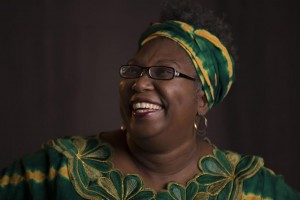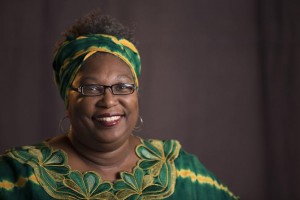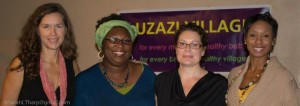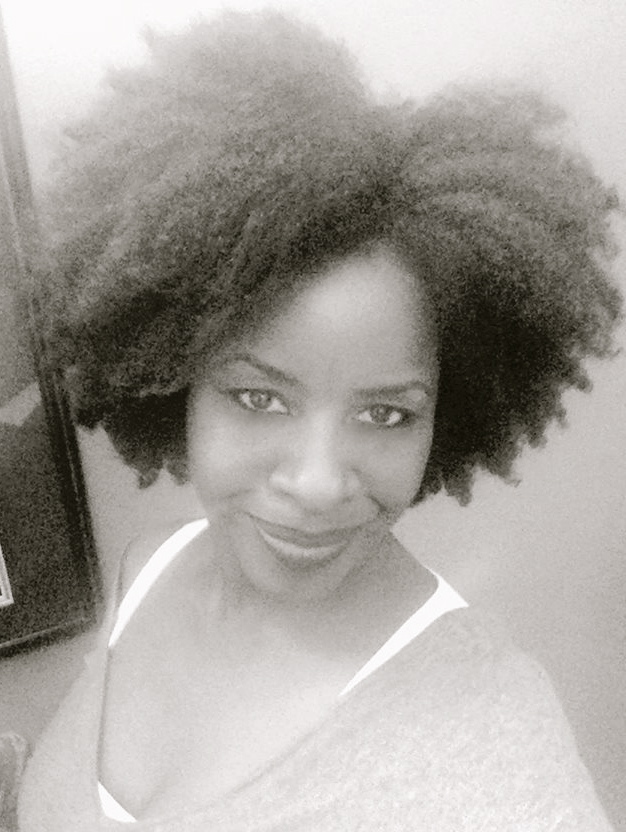An Interview with Sherry Payne: Nurse, Childbirth Educator, Womanist
Monica: I first became aware of your work through the Black Infant Mortality Awareness Walk. Can you tell me more about the circumstances that prompted you to launch this project?
Sherry: The walk came about because of my frustration with the maternity care world. Despite perinatal health disparities in the African-American community being well known and understood by the healthcare community, there seemed to be no discernable movement toward long term solutions. I wanted to do something grand, to make a statement. I thought a walk across my state would be just the thing.
Monica: What were the low points and high points of the Walk? What did you learn? What did others learn?
Sherry: Of course, the low point was the hit and run. The RV we were using was totaled. Logistically, there was no continuing from that point on. The high point was my day in Columbia, MO, in the middle of the state. I had walked six hours that day, then arrived in town in time for a newspaper interview, a radio interview, and then an in-person presentation. After that, we had a nice Q&A and then a dinner held in my honor at someone’s home. I fell into bed that night tired, but satisfied that I had reached so many people with my message that day. I learned from the entire walk, that there is much work to do and the walk was just the beginning. What I hoped others learned was an increased awareness about the issue and possible solutions.
Monica: Infant mortality – as we both advocate in our work – is about reproductive justice, racism, and poverty as much as it is about ‘genetics.’ Can you talk about how you came to your current perspective on reproductive justice? What other issues fit into the RJ framework?
Sherry: My perspective on reproductive justice has first and foremost formed by the needs of my community. When I think of how this framework ‘fits’ for my community, I think about the lack of access to dependable and efficacious contraceptives, I think about a maternity care complex that pathologizes Black women rather than promotes pregnancy wellness. I think about how the foster care system separates Black babies from their mothers and families. I think about how punitive the entire system is when it comes to women of color and their reproductive functions. The message seems to be: don’t be pregnant, but don’t expect any help to prevent a pregnancy, and if you do become pregnant you’ll be punished for it. The entire dynamic is sick.
As for genetics, the March of Dimes lists the leading causes of death for Caucasian infants as being genetic or chromosomal in nature. They list the leading causes of death for African-American infants as prematurity and low birth weight. Do you know the difference between those two leading causes of death? One is largely preventable and one is not. This means, of course, that African-American infants are dying from largely preventable causes. Our local epidemiologist uses the term, “excess deaths” to describe this phenomenon of Black babies dying in numbers at least twice as high as their White counterparts. Our babies are dying even when they should not be, even when their demise is preventable. (See page 17 of this report from the March of Dimes from 2012. Better yet, read this booklet cover to cover to get a great overview of infant mortality in the U.S.)
This is injustice at its most fundamental level.
Monica: How do you frame home birth for women of color? I’m thinking of recent stories celebrating home birth for Black women alongside other stories that point to the risk of arrest and prosecution for child abuse. How do you navigate these issues in your own practice?
Sherry: I love homebirth as an option for women of color. This is part of my master plan, to introduce an option to the unsafe, substandard, punitive system of ‘care’ that stands now as seemingly the only option for women of color and of low economic means. Women in my community need to know more about the option of having their babies at home, or in a birth center, where they can be respected and the sanctity of birth is restored. I hope to spend a lot of time talking about homebirth as a viable option for women. Yet, it can be a landmine fraught with hidden dangers for families of color navigating the healthcare system. They may be held suspect for opting out of ‘the system.’ They may be subject to greater scrutiny and may have to be more wary of exercising options that others take for granted.
Monica: Recently on your blog you noted a disagreement with a lactation advocacy site regarding Black breastfeeding mothers. Can you tell us more about this? What is at stake in this discussion?
Sherry: I was recently removed from a lactation online group for discussing Black infant mortality. It was seen as divisive and unpleasant. While I actually thought the discussion was going well, an administrator disagreed and removed me from the group. What I think is at stake in that discussion is, of course, increased awareness. We can’t solve a problem we don’t know exists. We also can’t find our way to a solution without meaningful dialogue among stakeholders. Though it may not sound like it on the surface, Black infant mortality is everyone’s problem. It points to a deep and unjust chasm in our healthcare system that unfairly targets those who suffer the greatest losses with the least amount of resources. Failure to engage this topic in the public discourse is to reject an acknowledgement of the problem and derails the work of finding viable solutions.
Monica: You’re trained as a nurse and a nurse educator, and you’re also now working on additional midwifery education. Why do you feel that you need the additional training, and specifically in midwifery? What do you hope to accomplish?
Sherry: By becoming a midwife, I hope to accomplish a lot! My goal is to open a clinic, birth center, and midwifery school to train midwives to serve our community. The midwifery piece is critical to the vision. We need a new model of prenatal care in this country as the current one does not serve its most vulnerable citizens. At Uzazi Village, we now have a small but mighty core of candidates working on becoming midwives. We serve as a beacon of light to those who wish to join us to transform society through radical maternity care, and of course to those who will be transformed by that care.
Monica: One of your state goals is to increase the number of women of color midwives. Why is this important?
Sherry: We need more midwives of color to provide culturally specific care. Women and babies are dying at an alarming rate in the African-American community. Our society, our healthcare system has offered no viable solutions. I propose flooding our communities with our own midwives to administer our own model of care. The way those midwives are trained is important, too. Our goal is community-focused training that respects and promotes healthy traditions and ways of being. The current system clearly isn’t working for us.
Monica: In your view as a practicing clinician and advocate for birthing women, what are the most pressing needs facing African American women, especially in your state?
Sherry: Right now the most pressing issue in my state (Missouri) is lack of access to Medicaid. Both Kansas and Missouri have declined Medicaid expansion and for the families that are eligible to access Medicaid, the waits are outrageous. Women can spend their entire pregnancies waiting to be approved by Medicaid. When they finally get approval and start prenatal care late, they are further punished for being ‘late to care’ through no fault of their own. Second to that, comprehensive coverage. I am always skittish when someone wants to limit what services women can access through their health insurance plans. We need more options for care, not fewer.
Monica: You note on your site that you’re interested in “decreasing health disparities in the urban core.” What are some other ways we can address stark disparities, including but not limited to midwifery and woman care?
Sherry: A lot of my work focuses around breastfeeding promotion. I believe the single most important thing a woman can do to improve her infant’s health (postnatally) is to make her milk available to her infant for as long as she can. This can still be a very hard sell in the African-American community. Promoting and supporting breastfeeding in a culturally congruent way is a very important part of decreasing perinatal health disparities.
Monica: You were walking through Missouri while Ferguson was dominating the news headlines. Do you see connections between your work and that of the Ferguson activists?
Sherry: I absolutely do see a connection. I have been working with a St. Louis group on a breastfeeding promotion project, but the schism between the Black and White communities there is so wide, I do not know if they can be breached. This is the social matrix that makes Black infant mortality possible, and the events of Ferguson, Missouri possible; fear, distrust, inability to connect or empathize.
Monica: In your view, what does a good ally look like? Any kind of ally you choose to talk about: an anti-racist ally, a pro-woman ally, a midwifery ally, a pro-reproductive justice ally…?
Sherry: I find it easy to describe because I see so few. Most allies mean well, but most don’t do well. They still try to lead or take over efforts that should be led from within the community. They still promote their own ideas and agendas and impose them on communities of color. A good ally follows, and allows the community to shine. In fact, a good ally will refuse to lead, refuse to take the spotlight, and save center stage for leadership from within the community. A good ally knows what is their work to do and what is not theirs to do. Good allies are few and far between.
Monica: Can you tell us about working with allies in the reproductive justice movement?
Sherry: Working alongside allies has been one of my biggest unexpected challenges. Most allies do not understand how to work with communities of color. I come into contact with far too many who are in White Savior mode. They do not yet understand that the role of an ally is to assist, or follow, not to lead. Often, they do not respond well to be reminded of their role should look like. These allies can use up a lot of valuable time and energy that should be going to the work itself. It is very important not to divert energy in this way. I understand that allies are socialized to lead, and are not used to ‘taking orders’ from persons of color, but this dynamic has to change. It can be a tremendous hindrance to moving forward on closing the gap in disparities.
All across the country, I watch organizations collect millions of dollars in tax payer funded grants, for ‘programs’ that have little to no connection to the communities they are supposed to impact. This is ally action at its worst. Meanwhile, leaders of color within communities of color scrape along as best they can with limited support or funding or recognition of their work. They are often forced to partner with these so-called ally organizations with mixed results. But doing what others think is best for our communities is not a winning strategy. Change must come from within. Leadership must come from within. The first thing an ally must do is their own internal inventory, and then take a long hard look at their organization’s approach.
Here is an example of an internal organizational audit. I encourage your readers to glance through it and answer for their organizations and see how they measure up (most will be found wanting). We really don’t know what racial equity looks like in this country. We know how to typecast people of color as victims, and dominant culture people as saviors, and most dominant culture folks are unnerved by straying from that script. Often, ally-run organizations don’t embody the principles of racial equity and diversity within the organizational framework itself, and therefore aren’t in any position to transfer those values into changes within communities of color via their programming. In short, good allyship is very difficult to find. Patronizing attitudes and paternalism, however, exists in great abundance.
Monica: Would you consider yourself a feminist? If so, why? And if not, why not?
Sherry: No, I would not. Perhaps more of a womanist. Feminism has not traditionally included the concerns of women of color. Neither do I see a lot of current effort to bridge the gap. I still see feminism as a middle-class white woman’s movement. Their issues are often not my issues or those of my community.
Monica: What advice would you give to a teenager interested in becoming a caregiver for birthing women?
Sherry: At Uzazi Village we support young women in their efforts to support birthing women and breastfeeding. We train young women to work with other young women. If they have the passion, we try to nurture and support that.
Monica: And just for fun, can you name five books (or songs) that changed your life?
 Sherry: I am an avid reader and have been my entire life. I was inspired to become a birthworker by Ina Mae Gaskins’s Spiritual Midwifery, I was inspired to walk by John Francis’s Planet Walker, and I was inspired to be a better me by Miguel Ruiz’s The Four Agreements. My ideologies have been greatly shaped by Alice Walker’s In Search of Our Mother’s Gardens and Steven Covey’s Seven Principles for Highly Effective People.
Sherry: I am an avid reader and have been my entire life. I was inspired to become a birthworker by Ina Mae Gaskins’s Spiritual Midwifery, I was inspired to walk by John Francis’s Planet Walker, and I was inspired to be a better me by Miguel Ruiz’s The Four Agreements. My ideologies have been greatly shaped by Alice Walker’s In Search of Our Mother’s Gardens and Steven Covey’s Seven Principles for Highly Effective People.
Monica: Is there anything else we should know about Sherry Payne?
Sherry: I am tough and determined and yet I could accomplish nothing of what I do without the constant and vigilant support of my team. I am humbled to be blessed with so many talented and intelligent people who uphold the vision of Uzazi Village and day by day make our work a reality.




2 Comments